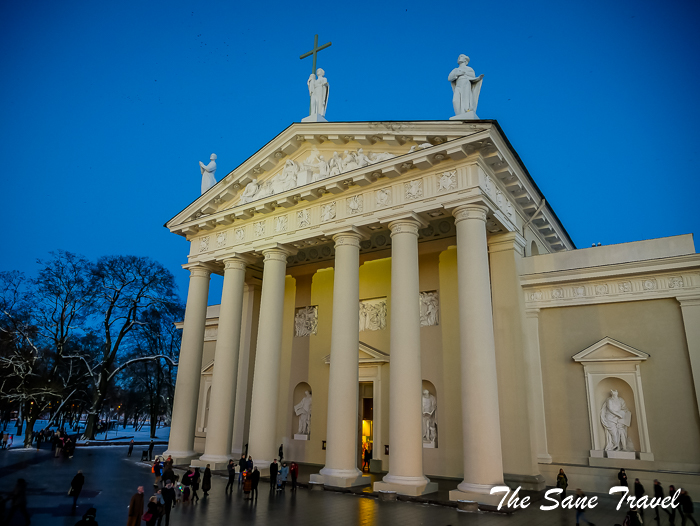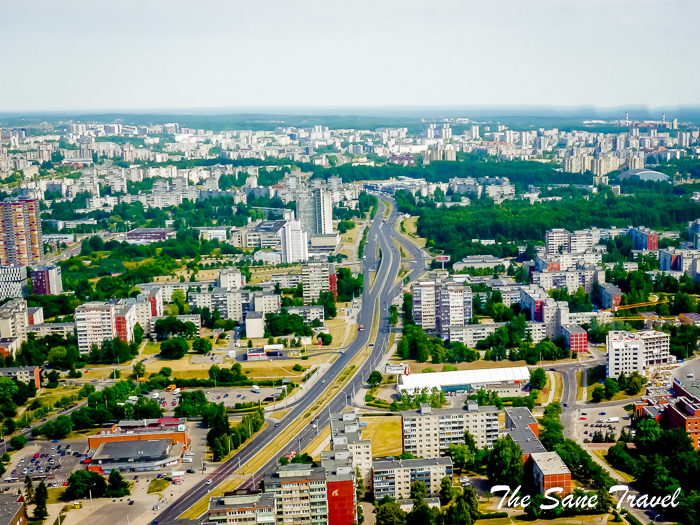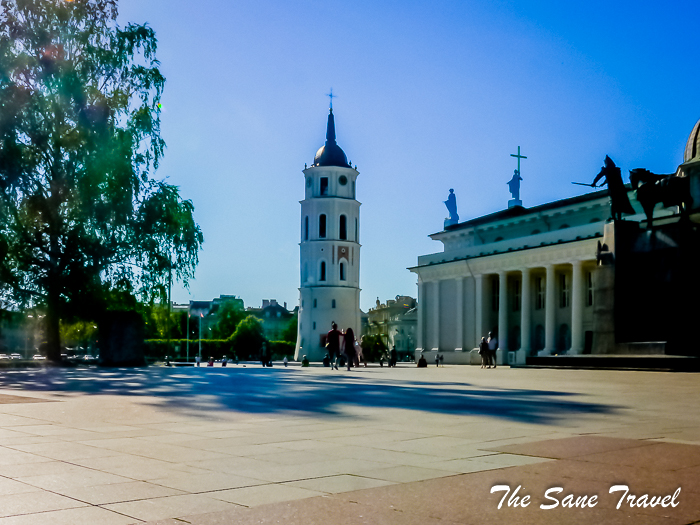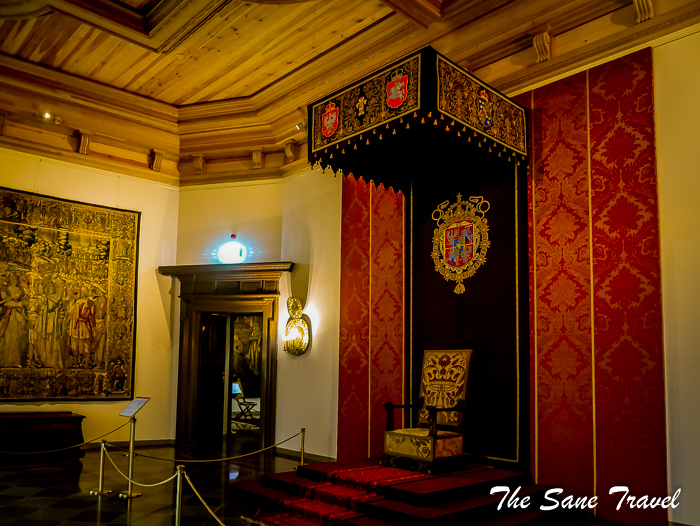Vilnius is the capital of Lithuania and its largest city, with a population of 543 thousand people. Vilnius is located in the southeast part of Lithuania and is the second largest city in the Baltic States after Riga. Old Town of Vilnius was declared a UNESCO World Heritage Site in 1994. Here is my list of 8 must see sights of Vilnius for a first time visitor.
1) City of Angels Entrance sign
Did you know that Vilnius, the capital of Lithuania, has a close relationship with angels? They are a symbol of the city. At the end of 2014, angels landed atop of road signs marking the entrance to the city that read: “Vilnius – City of Low Flying Angels”. T-shirts with a map of Vilnius held between angel wings are a popular souvenir of Vilnius. Alternatively, you can just bring a figurine of angel 👼 as a souvenir from your visit.
2) Gate of Dawn (Ausros Vartai)
The gate of Dawn is one of the main symbols of Vilnius and a shrine for Catholics. In 1503, the citizens of Vilnius were terrified by the Tatar invasion and asked Aleksandras (the Grand Duke of Lithuania) for permission to build a defensive wall around the city. The stone wall had defensive towers and five gates. It was finished in 1522. The Gate of Dawn with the picture of the Blessed Virgin Mary was in the most dangerous eastern part of the wall at the time. In the 16th century city gates often contained religious artefacts intended to guard the city from attacks and bless travellers. Under the order of the Russian tsarist government, the wall of the town was pulled down in early 19th century. But out of respect for the picture honoured by both Catholics and the Orthodox Church, the Gate of Dawn was left untouched. Now a renowned miraculous icon of the Blessed Virgin Mary Mother of Mercy is located in the Chapel of the Gate of Dawn. On September 4, 1993 Pope John Paul II said Rosary at the Gate of Dawn Chapel. Many visitors, as well as residents of Vilnius, like to come and pray at Aušros Vartai. The day of the Blessed Virgin Mary Mother of Mercy is celebrated on November 16. Devotion services last for a week around this date and attract many pilgrims from all over the country.
3) Cathedral Square and Tower
The Cathedral Square is the historic city centre, the most famous Lithuanian square. It used to be the location of the defence wall, towers and the Bishop’s Palace. Now the Cathedral Square hosts concerts, special events, celebrations and appearances of the Lithuanian Armed forces. The main Christmas tree of Lithuania is put up at Cathedral Square every year. Lighting the Vilnius Christmas Tree is an annual tradition of the Lithuanian capital and a sign that the festive season has truly arrived in the city! Every day you can see people sitting around the monument to Lithuanian Grand Duke Gediminas, resting and talking. The spacious Cathedral Square is abuzz day and night: it is much appreciated by bikers, skateboarders, couples or just passersby on a nice day.
In front of the cathedral stands the bell tower 57 meters tall. It is the former and best preserved tower of Vilnius defensive wall. In the belfry, bells were often replaced due to various reasons. During the wars bells were destroyed, appropriated by the occupiers for the war needs and used as raw metal. The huge bell of Sigismund in the Vilnius Cathedral, to sound which twelve men were needed, burned in a fire in 1610. Finally, in 2002, six new bells were consecrated in the Cathedral Square – it was a gift from the Archdiocese of Cologne. Today, the great bells weighing from 475 to 2.500 kg announce the beginning and the end of the day, invite to the Holy Mass and ceremonial celebrations in the Cathedral Square.
Next to the bell tower, on the pavement, you will find an exclusive tile. It is magical: Vilnius residents say that if you make a wish and turn around three times standing on top of the tile, your wish will come true. Try it and your inmost desires may soon be realised, who knows? If you liked Vilnius, then turn around on the magic tile, and make a wish to come back.
4) Cathedral
The Vilnius Cathedral is one of the most beautiful architectural masterpieces of classicism in the capital of Lithuania. It’s also notable for its magnetism strongly felt each time you approach it.

The vaults are a resting place for famous nobles, dukes and bishops of the Lithuanian Grand Duchy. Among them is the most powerful ruler of Lithuania, Vytautas the Great, and his wife Ona. The Grand Duke of Lithuania and King of Poland Alexander is buried in the Royal Mausoleum under the Chapel of St. Casimir. Here also rest two queens, two wives of Sigismund Augustus: Elzbieta Habsburgaite and Barbora Radvilaite. There are many legends about the latter. In the 16th century, she was even considered the most beautiful woman in Europe.
Cathedral catacombs
Another important part of the Cathedral is its catacombs. In 1931, the Cathedral was flooded by the river Neris. During its repair, a number of crypts were found with the remains of some members of the royal family, for whom a mausoleum was designed in the years that followed. Also, in the Cathedral catacombs, one can see the remains of the first Mindaugas cathedral and the older pagan temple from 13th century.
5) National Museum, The Palace of the Grand Dukes of Lithuania
Grand dukes of Lithuania had their residences in Lower as well as in Upper Castle. Til the end of the 15th century, their main place of residence remained the Upper Castle where the remains of the gothic palace can still be seen nowadays. During the 15th century, the grand dukes of Lithuania also liked to live in the castles of Trakai. Grand Duke Alexander Jagiellon (1492–1506) moved his residence from the Upper to the Lower Castle.
The period of 16th and 17th centuries was the time of prosperity for the Vilnius residence of the grand dukes of Lithuania and the kings of Poland. This gorgeous residence surrounded by the picturesque park had become a centre of Renaissance and Early Baroque culture and art not only in the Grand Duchy of Lithuania but also in all Central Eastern and Northern Europe.
The prosperity of Vilnius’ Palace ended in 1655 with the Muscovite and Cossack armies’ occupation of Lithuania’s capital for 6 years. Armies devastated and looted the Palace of the Grand Dukes, using it as a shelter. In 1661, the Palace was devastated repeatedly when efforts were made to banish the enemy.

![21 vilnius castle interior lithuania www.thesanetravel.com 1000778]() 6) Gediminas tower
6) Gediminas tower
It is said that Gediminas Castle was built when the Duke of Lithuania Gediminas had a prophetic dream. This small but powerful castle withstood numerous Crusader attacks. Now Vilnius is unthinkable without it, and the tower of the castle became a symbol of not only the capital city, but also of all Lithuania. And it’s not surprising that this red-brick building overlooking the magnificent panorama of the capital is a must on the list of many tourists coming to Lithuania.
Gediminas tower, the only building left from the upper castle, is clearly visible from everywhere. Like Vilnius, the castle was first mentioned in 1323. On January 1 in 1919, after the restoration of the state of Lithuania, the country’s flag was officially raised for the first time on the Gediminas Castle Tower.


One more thing worth noticing is that the beginning of the Baltic Way in 1989 was in Vilnius, just outside the Gediminas tower. From here, a magnificent line of people holding hands stretched for 600 kilometres over three countries, ending at Hermann tower in Tallinn.
7) President Palace
Although it’s only been converted into Lithuania's presidential seat in 1997, a palace has existed on this spot since the 14th century. For 250 years it served as a residence of the Archbishops of Vilnius before the partitions of Poland-Lithuania complicated the matter.
In the 18th century it was the home of the General Governors. It has been visited by Napoleon as well as Russian Tsar Alexander. The palace has a beautiful inside yard and a vine cellar. If you are lucky like me, you may even see Lithuanian President at her palace.
![35 president lithuania vilnius summer www.thesanetravel.com 1260322]() 8) TV tower
8) TV tower
Vilnius TV tower is the tallest building in Lithuania (326,5 m) and is included in the list of the world's tallest buildings. If you want to have a look at Vilnius from high above, ascend to the top of the tower and enjoy the full panorama of the city. Finding the tower is very easy – it is visible from almost any location in Vilnius. In the rotating restaurant, at a height of 165 meters, you can enjoy some food with a wonderful view of the entire of Vilnius. Since 2000, the TV tower was decorated like a Christmas tree every Christmas season.

Read about seven ways to learn more about Vilnius clicking this link. When in Lithuania visit culture capital of 2020 beautiful Kaunas.
Have you been to Vilnius? What is your favorite spot in the city? Share in the comments section! Published by Anita on February 04, 2017
Published by Anita on February 04, 2017
Author: Anita Sāne

About the author
Anita is a part-time traveller, passionate photographer and a retired career woman from Latvia, travelling mostly solo for more than 15 years. She is a skilled travel planner who plans and executes her travels by herself. Anita wants to show you how to travel the world and open your mind to new experiences. Follow her on Facebook, Instagram, Pinterest, Twitter and Bloglovin.










 6) Gediminas tower
6) Gediminas tower

 8) TV tower
8) TV tower









Report
My comments